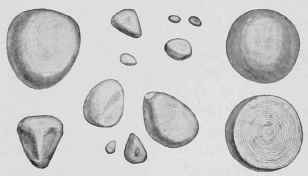Pus In The Guttural Pouches
Description
This section is from the book "The Horse - Its Treatment In Health And Disease", by J. Wortley Axe. Also available from Amazon: The Horse. Its Treatment In Health And Disease.
Pus In The Guttural Pouches
The guttural pouches (fig. 204) are two somewhat capacious cavities situated between the base of the skull above and the pharynx and larynx below. The inner walls of the sacs are in apposition with each other, while their outer walls are for the most part covered with the parotid glands. They communicate with the pharynx by two openings - the eustachian tubes, and their function would appear to be in some way connected with the sense of hearing, and at the same time to allow the free expansion of the pharynx in the act of swallowing and of the larynx in breathing.
They are lined by mucous membrane which is continuous with that lining the throat. It occurs, therefore, that inflammatory affections of the latter sometimes extend to the former, as is now and again the case in strangles, influenza, and pharyngitis, with the result that one or both guttural pouches become more or less distended with pus.
Symptoms
Here there is a chronic discharge from one or both nostrils, generally of an intermittent character, sometimes constant, but always variable in amount. The flow of matter is greatly increased under certain conditions, notably when the head is held low, as in eating and drinking from the ground. During mastication coughing is induced in the act of swallowing, when the pellet of food is sometimes expelled from the mouth into the manger. In some cases of this kind, where post-mortem examination has been made, the pus has been found to have formed itself into numerous solid concretions varying in size from a pea to a walnut, some being rounded, others angular and faceted masses (fig. 205). In structure all are laminated or formed in layers.

Fig. 204. - Transverse Section of Horse's Head, showing the Guttural Pouches.
A, Brain. B, Maxillary Condyle. c, Sphenoid Bone. D, D, Guttural Pouches. E, Great Cornu of Hyoid Bone. f, F, Eustachian Tubes. G, Oesophagus. H, H, Parotid Glands.

Fig. 205. - Concretions of Pus from the Guttural Pouches.
The presence of angular specimens shows them to have existed some considerable time, and, by rubbing one against another, to have worn down the original rounded surface into a number of facets.
The disease may be confined to one pouch, or extend to both. The affected side of the throat in the region of the parotid gland is full or distinctly swollen. Pressure applied to this part induces pain, and if deep pressure be made, matter is sometimes caused to flow from the nostrils in large amount. If the escape of pus be prevented by partial or complete closure of the escape holes in the eustachian tubes, the accumulation of matter becomes so great as to interfere with swallowing, and pressure on the larynx induces a noisy or roaring sound in breathing. Under these circumstances the outward swelling would be very considerable and marked by distinct fluctuation.
Treatment
It is frequently the case that this abnormal condition of the guttural pouches is in existence for a considerable time before it is recognized. The continuous discharge from the nostrils following upon strangles and influenza is generally regarded as the result of a catarrhal state of the nasal membrane, and it is not until some interference with swallowing, or breathing, or some enlargement in the region of the throat takes place that the actual state of affairs becomes recognized. Before proceeding to any heroic measures of treatment, it may be desirable to try the effects of a run at grass and a blister to the throat. As the downward position of the head assumed in grazing favours the discharge of the matter, and the emptying of the sac, this may have the desired effect. Should it not do so, then the distended pouch or pouches will require to be punctured and their contents evacuated. This is an operation that calls for expert assistance, as there are numerous important vessels and nerves in the region of the throat which it would be dangerous to injure.
The operation consists in cutting through the skin behind the posterior edge of the parotid gland, about 4 to 5 inches below the ear, and over the seat of the most fluctuating point. This having been done, a hole is made into the pouch either by dissection or, what is safer, by carefully thrusting a blunt-pointed instrument something like a pen-holder, but having a wider base, through the tissues into the sac, and then cautiously enlarging the opening upward and downward with the knife. When the sac has been emptied, it should be thoroughly washed out with a weak solution of carbolic acid. This should be done, if possible, while the horse's head is inclined downwards, which position he may be made to assume by feeding him on the ground. As a repetition of the injection will require to be made on the two following days, the aperture should be kept open by introducing into it a piece of india-rubber tubing and keeping the patient tied up by the head. The subsequent injections can then be made through the tubing.
Continue to:


